- Accueil
- Pages cachées
- 23 FEVRIER 2024 NEWS
23 FEVRIER 2024 NEWS
INSTITUT SUPERIEUR D'ANTHROPOLOGIE
INSTITUTE OF ANTHROPOLOGY
ONLINE COURSES / COURS A DISTANCE
INSCRIPTIONS OUVERTES
REGISTER NOW
INDE –  Lodrani - Locals of Lodrani, a hamlet around 51 km from Dholariva, a Harappan settlement in Kutch, had begun digging in the area with the belief that there was gold buried. However, what they ended up finding is a new Harappan settlement that experts say might date back to around 2600 BC, according to a report by Times of India. Lodrani was actually a fortified settlement during the Harappan civilization. Ajay Yadav and Damian Robinson, researches working with Oxford's School of Archeology, who are the leading arcchaelogists in this excavation, said that architecture at Lodrani closely resembles that of Dholariva, which is a UNESCO World Heritage site...In an interview with TOI, Yadav said, "Villagers believed there was a medieval fortress and buried treasure. But when we examined the site, we found a Harappan settlement where life was flourishing some 4,500 years ago."According to Yadav, it produced a significant amount of Harappan pottery, comparable to that discovered in Dholavira. The settlement appears developed from mature (2,600–1,900 BCE) to late Harappan times (1,900–1,900 BCE) to . Further research and excavation, according to archaeologists, will uncover more.
Lodrani - Locals of Lodrani, a hamlet around 51 km from Dholariva, a Harappan settlement in Kutch, had begun digging in the area with the belief that there was gold buried. However, what they ended up finding is a new Harappan settlement that experts say might date back to around 2600 BC, according to a report by Times of India. Lodrani was actually a fortified settlement during the Harappan civilization. Ajay Yadav and Damian Robinson, researches working with Oxford's School of Archeology, who are the leading arcchaelogists in this excavation, said that architecture at Lodrani closely resembles that of Dholariva, which is a UNESCO World Heritage site...In an interview with TOI, Yadav said, "Villagers believed there was a medieval fortress and buried treasure. But when we examined the site, we found a Harappan settlement where life was flourishing some 4,500 years ago."According to Yadav, it produced a significant amount of Harappan pottery, comparable to that discovered in Dholavira. The settlement appears developed from mature (2,600–1,900 BCE) to late Harappan times (1,900–1,900 BCE) to . Further research and excavation, according to archaeologists, will uncover more.
https://www.deccanherald.com/india/gujarat/gold-rush-reveals-a-lost-harappan-settlement-near-gujarats-kutch-report-2902249
GRECE – 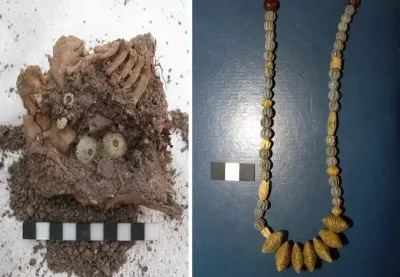 Aegina - The first confirmed case of Down syndrome in Ancient Greece was found on the island of Aegina, according to research published in the journal Nature Communications.DNA analysis on the skeleton of a girl aged 12-16 months, who lived in the 13th century BC, in a Mycenaean settlement near the village of Lazaridis, showed that the child suffered from Down syndrome. The syndrome is a genetic condition where a person is born with an extra copy of chromosome 21. This means that they have a total of 47 chromosomes instead of 46. This can affect how their brain and body develop. The girl was buried wearing an elaborate necklace made of 93 beads of faience and vitreous, as well as six of cornelian, a finding indicative of the care he received in life and death. In 2010 the excavation in the settlement brought to light an unexpected find, a small box-shaped tomb, dated to the 13th century BC. The find was soon to become very exciting for archaeologists: inside the grave were the bones of a small child along with an elaborate necklace. The osteological research carried out on the skeletal material by the bioarchaeologist, Dr. Eleanna Prevedorou, found that she had morphological characteristics of skeletal changes indicative of a very serious chronic disease or diseases. In other words, she was a little girl “who spent most, if not all, of her life very ill and suffered from intense pain”, as Prevedorou tells AMNA. Later genetic analyses of samples of the material carried out at the Max Planck Institute for Evolutionary Anthropology, in Germany, revealed that this little girl also suffered from Down syndrome. “However we do not yet know whether and to what extent the severe health problems detected osteologically were associated with the syndrome”, Prevedorou explains. This finding is very important, as it is the first time that a case of Down syndrome has been identified in Greece during antiquity, emphasizes the professor emeritus of EKPA, Naia Polychronakou-Sgouritsa, clarifying however that “there may be others, which however have been examined by a large institute, such as Max Planck. Only a few cases of Down syndrome have been recorded in humans in ancient times, mainly because of the difficulties in identifying genetic disorders in ancient DNA samples without the use of modern techniques.
Aegina - The first confirmed case of Down syndrome in Ancient Greece was found on the island of Aegina, according to research published in the journal Nature Communications.DNA analysis on the skeleton of a girl aged 12-16 months, who lived in the 13th century BC, in a Mycenaean settlement near the village of Lazaridis, showed that the child suffered from Down syndrome. The syndrome is a genetic condition where a person is born with an extra copy of chromosome 21. This means that they have a total of 47 chromosomes instead of 46. This can affect how their brain and body develop. The girl was buried wearing an elaborate necklace made of 93 beads of faience and vitreous, as well as six of cornelian, a finding indicative of the care he received in life and death. In 2010 the excavation in the settlement brought to light an unexpected find, a small box-shaped tomb, dated to the 13th century BC. The find was soon to become very exciting for archaeologists: inside the grave were the bones of a small child along with an elaborate necklace. The osteological research carried out on the skeletal material by the bioarchaeologist, Dr. Eleanna Prevedorou, found that she had morphological characteristics of skeletal changes indicative of a very serious chronic disease or diseases. In other words, she was a little girl “who spent most, if not all, of her life very ill and suffered from intense pain”, as Prevedorou tells AMNA. Later genetic analyses of samples of the material carried out at the Max Planck Institute for Evolutionary Anthropology, in Germany, revealed that this little girl also suffered from Down syndrome. “However we do not yet know whether and to what extent the severe health problems detected osteologically were associated with the syndrome”, Prevedorou explains. This finding is very important, as it is the first time that a case of Down syndrome has been identified in Greece during antiquity, emphasizes the professor emeritus of EKPA, Naia Polychronakou-Sgouritsa, clarifying however that “there may be others, which however have been examined by a large institute, such as Max Planck. Only a few cases of Down syndrome have been recorded in humans in ancient times, mainly because of the difficulties in identifying genetic disorders in ancient DNA samples without the use of modern techniques.
https://greekreporter.com/2024/02/21/first-case-down-syndrome-found-ancient-greece/
SUISSE – 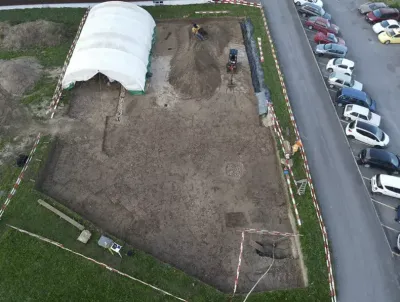
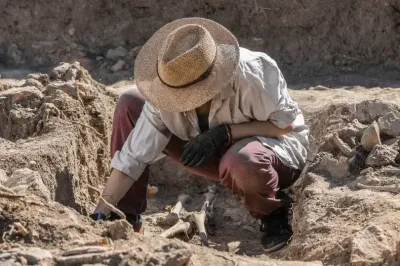 Heimberg - Mystery surrounds the remains of a previously unknown prehistoric settlement next to a road that has been discovered by archaeologists. The Bronze Age settlement, thought to date to around 3,200-3,500 years ago, was uncovered by the Schulgässli road in the municipality of Heimberg, Switzerland, the Archaeological Service of the Canton of Bern (ASCB) announced in a press release. In advance of a construction project, the archaeological service carried out a rescue excavation at the site in the fall of 2023 in the expectation that the investigations would reveal an ancient brick workshop from the Roman era. But no remains of such a workshop were found—instead, archaeologists unexpectedly identified traces of a Bronze Age settlement. The rescue excavations, which took place over the course of three months, revealed various traces of the prehistoric settlement, but several aspects of the site remain a mystery. Among the structures that the researchers uncovered were ditches and several pits, some of which were filled to the brim with stones. These stones appear to have been shattered by significant heat, although researchers are not exactly sure what their original purpose was. "It is not clear what these pits with the fragmented stones were used for," Stapfer said. It is conceivable that the stones were heated in a fire and then placed in the pits to provide warmth for the Bronze Age community, according to the archaeologist. Another possible explanation is that they were used for cooking purposes. Similar pits have previously been found at other settlements dated to the Middle Bronze Age. The archaeological service also identified other pits at the site that may be evidence of clay extraction. At the time, clay was an important raw material used for various purposes, such as to plaster the wicker walls of houses or to produce ceramics. The excavations at the site revealed a relatively large quantity of prehistoric pottery. The style and decoration of the pottery indicates that the ceramic artifacts date to around 1500-1200 B.C.—providing an age for the settlement. Only part of the Bronze Age settlement has been excavated so far, thus, its original size is not yet known, according to Stapfer. The true identity of the Bronze Age people who once inhabited the site also remains unknown, although it is likely that they came from the region. "We know of no burial ground for the settlement and therefore have no evidence of the people who inhabited the settlement," Stapfer said.
Heimberg - Mystery surrounds the remains of a previously unknown prehistoric settlement next to a road that has been discovered by archaeologists. The Bronze Age settlement, thought to date to around 3,200-3,500 years ago, was uncovered by the Schulgässli road in the municipality of Heimberg, Switzerland, the Archaeological Service of the Canton of Bern (ASCB) announced in a press release. In advance of a construction project, the archaeological service carried out a rescue excavation at the site in the fall of 2023 in the expectation that the investigations would reveal an ancient brick workshop from the Roman era. But no remains of such a workshop were found—instead, archaeologists unexpectedly identified traces of a Bronze Age settlement. The rescue excavations, which took place over the course of three months, revealed various traces of the prehistoric settlement, but several aspects of the site remain a mystery. Among the structures that the researchers uncovered were ditches and several pits, some of which were filled to the brim with stones. These stones appear to have been shattered by significant heat, although researchers are not exactly sure what their original purpose was. "It is not clear what these pits with the fragmented stones were used for," Stapfer said. It is conceivable that the stones were heated in a fire and then placed in the pits to provide warmth for the Bronze Age community, according to the archaeologist. Another possible explanation is that they were used for cooking purposes. Similar pits have previously been found at other settlements dated to the Middle Bronze Age. The archaeological service also identified other pits at the site that may be evidence of clay extraction. At the time, clay was an important raw material used for various purposes, such as to plaster the wicker walls of houses or to produce ceramics. The excavations at the site revealed a relatively large quantity of prehistoric pottery. The style and decoration of the pottery indicates that the ceramic artifacts date to around 1500-1200 B.C.—providing an age for the settlement. Only part of the Bronze Age settlement has been excavated so far, thus, its original size is not yet known, according to Stapfer. The true identity of the Bronze Age people who once inhabited the site also remains unknown, although it is likely that they came from the region. "We know of no burial ground for the settlement and therefore have no evidence of the people who inhabited the settlement," Stapfer said.
ISRAEL – 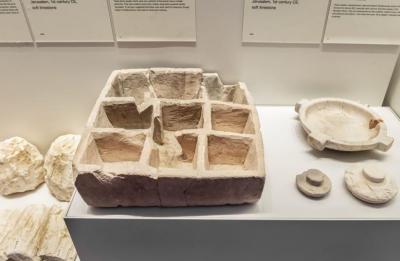 Jerusalem - A rare and mysterious, multi-compartment stone container dating back to the days of the Second Temple that serves as evidence of the destruction of Jerusalem two millennia ago has been put on display for the first time at the Israel Museum in the capital. The square box was discovered during excavations conducted by the Israel Antiquities (IAA) in the City of David part of the Jerusalem Walls National Park. Measuring 30 x 30 centimeters, it was carved from soft limestone and divided inside into nine equal-sized compartments. The multi-compartment container was discovered in a destruction layer inside an ancient store dated to the end of the Second Temple period that once stood alongside the Pilgrimage Road in the City of David. The sides of the box are black, indicating that it was burnt – perhaps during events of the Great Jewish Revolt that ultimately led to the destruction of Jerusalem. Researchers assume that the box was used for commercial purposes like displaying premeasured goods. According to IAA excavation directors Dr. Yuval Baruch and Ari Levy, “During excavations of the Pilgrimage Road where the box was discovered, many objects have been found as testament to the flourishing commercial activity that took place alongside the road during the Second Temple period. We uncovered ceramic and glass vessels, production and cooking facilities, various measuring tools, stone weights, and coins. Together, these objects suggest that the road was connected to commercial activities such as a lively urban market.” The Pilgrimage Road connecting the Pool of Siloam to the Temple Mount was the main thoroughfare of the city 2,000 years ago. It seems that the newly discovered box was related to this commercial activity that took place along the Pilgrimage Road, they suggested.
Jerusalem - A rare and mysterious, multi-compartment stone container dating back to the days of the Second Temple that serves as evidence of the destruction of Jerusalem two millennia ago has been put on display for the first time at the Israel Museum in the capital. The square box was discovered during excavations conducted by the Israel Antiquities (IAA) in the City of David part of the Jerusalem Walls National Park. Measuring 30 x 30 centimeters, it was carved from soft limestone and divided inside into nine equal-sized compartments. The multi-compartment container was discovered in a destruction layer inside an ancient store dated to the end of the Second Temple period that once stood alongside the Pilgrimage Road in the City of David. The sides of the box are black, indicating that it was burnt – perhaps during events of the Great Jewish Revolt that ultimately led to the destruction of Jerusalem. Researchers assume that the box was used for commercial purposes like displaying premeasured goods. According to IAA excavation directors Dr. Yuval Baruch and Ari Levy, “During excavations of the Pilgrimage Road where the box was discovered, many objects have been found as testament to the flourishing commercial activity that took place alongside the road during the Second Temple period. We uncovered ceramic and glass vessels, production and cooking facilities, various measuring tools, stone weights, and coins. Together, these objects suggest that the road was connected to commercial activities such as a lively urban market.” The Pilgrimage Road connecting the Pool of Siloam to the Temple Mount was the main thoroughfare of the city 2,000 years ago. It seems that the newly discovered box was related to this commercial activity that took place along the Pilgrimage Road, they suggested.
https://www.jpost.com/archaeology/article-788092
GALLES – Pontrhydfendigaid - An ancient, possibly (probably) Celtic monastery may have once laid at the site of a 12th century Cistercian abbey near the Cambrian Mountains by Pontrhydfendigaid village, archaeologists told Nation Cymru. The discovery came amid an analysis of a courtyard next to the abbey, in a farm building called Mynachlog Fawr at the Strata Florida site. The abbey and farm buildings were in the process of refurbishment when the features of the Celtic monastery started to reveal themselves, including a major aqueduct and other medieval buildings believed to be part of the structure. Samples from the site were analyzed using radiocarbon methods and were shown to have come from between 1166-1268 AD, 1028-1172 AD and, oddly, 1017-1158 AD. “The last two of these dates are from the earlier building and, given that the Cistercian abbey was not founded on this site until 1184, they seem to suggest that the building is pre-Cistercian in date,” said the local trust director Carys Aldous-Hughes, according to Nation Cymru. “One of the main focuses of the upcoming 2024 excavations will be the further examination of this building by attempting to find its original floors and any features associated with its earlier use and function. These will offer a glimpse into the history of this site before the Cistercians arrived.”
DANEMARK – 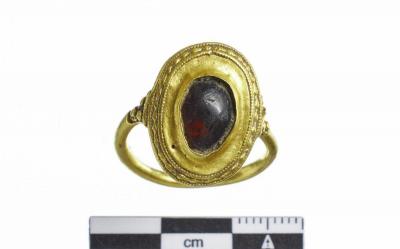
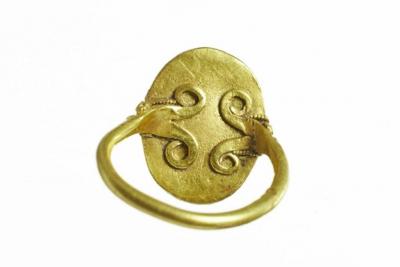 Emmerlev - A metal detectorist has unearthed a very rare, 1,500-year-old Merovingian gold ring made of 22-carat gold at Emmerlev in Southwest Jutland, Denmark. Archaeologists believe the ring may shed light on a previously unknown lineage of royal figures with ties to powerful European dynasties during the early Medieval period. Dating back to 500-600 CE, the ring is adorned with an oval cabochon almandine garnet, a prized red semi-precious stone symbolizing power among Germanic peoples. For the Germanic peoples, the almandine garnet was a symbol of power. The gold ring’s design, featuring four spirals on the underside and trefoil knobs where the band meets the bezel, showcases the highest quality of Frankish craftsmanship, indicative of its elite wearer. Jewellery and rings of this type were worn exclusively by the elite of the Merovingian dynasty. The spiral embellishments and three-lobed settings are hallmarks of Frankish metalworking from this period, said Kirstine Pommergaard, a curator at the museum. Experts from the National Museum of Denmark and Museum Sønderjylland analyzed the ring and concluded that its presence in Emmerlev indicates the existence of a princely family with close ties to the Merovingian rulers. “The gold ring not only reveals a possible new princely family in Emmerlev but also connects the area with one of Europe’s largest centers of power in the Iron Age. The gold ring is probably a woman’s ring and may have belonged to a prince’s daughter who was married to a prince in Emmerlev. Gold was typically reserved for diplomatic gifts, and we know that people married into alliances, just it probably happened with Thyra and Gorm the Old and in more recent times when Christian IX became known as ‘Europe’s father-in-law’ for marrying his daughters into other royal houses, ” said Pommergaard. Other objects have been found in the same area – most notably two gold and seven silver coins or Frisian-turned pottery, which confirm contact with the Merovingian area, probably through allies in Friesland.
Emmerlev - A metal detectorist has unearthed a very rare, 1,500-year-old Merovingian gold ring made of 22-carat gold at Emmerlev in Southwest Jutland, Denmark. Archaeologists believe the ring may shed light on a previously unknown lineage of royal figures with ties to powerful European dynasties during the early Medieval period. Dating back to 500-600 CE, the ring is adorned with an oval cabochon almandine garnet, a prized red semi-precious stone symbolizing power among Germanic peoples. For the Germanic peoples, the almandine garnet was a symbol of power. The gold ring’s design, featuring four spirals on the underside and trefoil knobs where the band meets the bezel, showcases the highest quality of Frankish craftsmanship, indicative of its elite wearer. Jewellery and rings of this type were worn exclusively by the elite of the Merovingian dynasty. The spiral embellishments and three-lobed settings are hallmarks of Frankish metalworking from this period, said Kirstine Pommergaard, a curator at the museum. Experts from the National Museum of Denmark and Museum Sønderjylland analyzed the ring and concluded that its presence in Emmerlev indicates the existence of a princely family with close ties to the Merovingian rulers. “The gold ring not only reveals a possible new princely family in Emmerlev but also connects the area with one of Europe’s largest centers of power in the Iron Age. The gold ring is probably a woman’s ring and may have belonged to a prince’s daughter who was married to a prince in Emmerlev. Gold was typically reserved for diplomatic gifts, and we know that people married into alliances, just it probably happened with Thyra and Gorm the Old and in more recent times when Christian IX became known as ‘Europe’s father-in-law’ for marrying his daughters into other royal houses, ” said Pommergaard. Other objects have been found in the same area – most notably two gold and seven silver coins or Frisian-turned pottery, which confirm contact with the Merovingian area, probably through allies in Friesland.
CHINE – 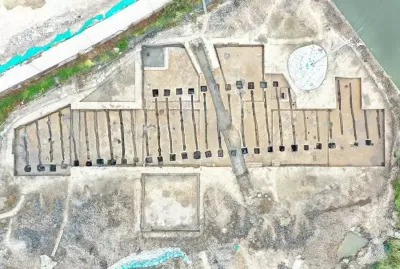
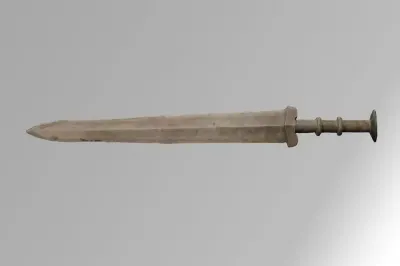 Shaoxing - Chinese archaeologists have released details of a cluster of building ruins in east China's Zhejiang Province, believed to be related to the ancient capital of the Yue Kingdom, which preceded the Qin Dynasty (221 BC-207 BC). This was reported by The Xinhua News Agency. The experts have been conducting excavations at 10 large-scale sites in Shaoxing City of Zhejiang since 2020, unearthing the remains of large buildings and various ancient artefacts of great significance for future research. The cluster covers a total area of some 7 square kilometers, and includes the three main sites of Tingshan, Nanshan and Nanshantou. They are located close to the royal mausoleum of the founder of Xia Dynasty (2070 BC-1600 BC). "Among the most significant finds was a 180-cm-thick layer of building remains located at the top of Tingshan Mountain, at the core of the cluster", – according to Xu Xinmin, researcher from the provincial institute of cultural relics and archaeology, who is in charge of the overall excavation project. "Some quay ruins and pits for ritual ceremonies containing the remains of sacrificial offerings were also found at the Tingshan Site", – said Xu. In the southern part of the Tingshan Site, a massive building foundation was unearthed, with delicate lacquer decorations painted on the remains of the pillars. Xu explained the building is believed to have been a high-grade public ritual space at that time. Meanwhile, some platform-like foundations were unearthed at the Nanshan Site, containing abundant pottery, primitive porcelain, metal-ware, bamboo and wood-ware, as well as animal and plant remains. Notably, multiple items of bronze-ware, including a spear and a dagger-axe, both with character inscriptions indicating the king, as well as seven swords, were also discovered at the Nanshan Site. "The bones of cattle, pigs, deer and freshwater fish were also found at the site. Surprisingly, rare bones of horses from the Yue Kingdom and tuna bones, which can only be found in the deep sea, were among the remains. The remains of crops, vegetables and fruits have also been found", – according to Xu. "At the Nanshantou Site, researchers found a huge tile, which is 48-cm-long and 36-cm-wide. The tile illustrates the magnificent scale of the building at the site", – Xu added. Based on the new findings, the researchers have come to a preliminary conclusion that the main three sites – namely Tingshan, Nanshantou and Nanshan – are interlinked to form a functional area for the core region of the Yue Kingdom, and may have belonged to the kingdom's capital. Known collectively as the Tingshan complex, the sites are expected to reveal the social organization structure, subsistence economy, transportation, trade and other social-life conditions before and after the establishment of Yue Kingdom, taking into account the swampy environment at that time, with mountains facing the sea and rivers criss-crossing its territory", – according to Xu. Luo Rupeng, a researcher with the same institute as Xu, said the discovery of the Tingshan complex is very important for the archaeological study of the Shang and Zhou dynasties (1600 BC-256 BC) in Zhejiang. Local archaeological research authorities, including Zhejiang provincial institute of cultural relics and archaeology, have been conducting excavation work at the sites since 2020, with an accumulative excavation area of more than 20,000 square meters so far.
Shaoxing - Chinese archaeologists have released details of a cluster of building ruins in east China's Zhejiang Province, believed to be related to the ancient capital of the Yue Kingdom, which preceded the Qin Dynasty (221 BC-207 BC). This was reported by The Xinhua News Agency. The experts have been conducting excavations at 10 large-scale sites in Shaoxing City of Zhejiang since 2020, unearthing the remains of large buildings and various ancient artefacts of great significance for future research. The cluster covers a total area of some 7 square kilometers, and includes the three main sites of Tingshan, Nanshan and Nanshantou. They are located close to the royal mausoleum of the founder of Xia Dynasty (2070 BC-1600 BC). "Among the most significant finds was a 180-cm-thick layer of building remains located at the top of Tingshan Mountain, at the core of the cluster", – according to Xu Xinmin, researcher from the provincial institute of cultural relics and archaeology, who is in charge of the overall excavation project. "Some quay ruins and pits for ritual ceremonies containing the remains of sacrificial offerings were also found at the Tingshan Site", – said Xu. In the southern part of the Tingshan Site, a massive building foundation was unearthed, with delicate lacquer decorations painted on the remains of the pillars. Xu explained the building is believed to have been a high-grade public ritual space at that time. Meanwhile, some platform-like foundations were unearthed at the Nanshan Site, containing abundant pottery, primitive porcelain, metal-ware, bamboo and wood-ware, as well as animal and plant remains. Notably, multiple items of bronze-ware, including a spear and a dagger-axe, both with character inscriptions indicating the king, as well as seven swords, were also discovered at the Nanshan Site. "The bones of cattle, pigs, deer and freshwater fish were also found at the site. Surprisingly, rare bones of horses from the Yue Kingdom and tuna bones, which can only be found in the deep sea, were among the remains. The remains of crops, vegetables and fruits have also been found", – according to Xu. "At the Nanshantou Site, researchers found a huge tile, which is 48-cm-long and 36-cm-wide. The tile illustrates the magnificent scale of the building at the site", – Xu added. Based on the new findings, the researchers have come to a preliminary conclusion that the main three sites – namely Tingshan, Nanshantou and Nanshan – are interlinked to form a functional area for the core region of the Yue Kingdom, and may have belonged to the kingdom's capital. Known collectively as the Tingshan complex, the sites are expected to reveal the social organization structure, subsistence economy, transportation, trade and other social-life conditions before and after the establishment of Yue Kingdom, taking into account the swampy environment at that time, with mountains facing the sea and rivers criss-crossing its territory", – according to Xu. Luo Rupeng, a researcher with the same institute as Xu, said the discovery of the Tingshan complex is very important for the archaeological study of the Shang and Zhou dynasties (1600 BC-256 BC) in Zhejiang. Local archaeological research authorities, including Zhejiang provincial institute of cultural relics and archaeology, have been conducting excavation work at the sites since 2020, with an accumulative excavation area of more than 20,000 square meters so far.
ISRAEL – 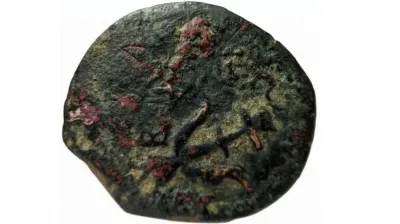 Kibbutz Magen - Displaced since the Hamas-led October 7 attacks on southern Israel, an 11-year-old boy from Kibbutz Magen found a 2,000-year-old Hasmonean era coin while exploring his temporary accommodations at the Dead Sea, the Israel Antiquities Authority (IAA) announced. As for the special find, Dr. Robert Kool who heads the coin division at the IAA described it as “a coin of Hasmonean king and high priest Alexander Jannaeus (104-76 BCE). On the face of the coin appears an anchor, and around it appears an inscription in Greek - ‘Alexander Basileus,’ which translates to ‘(of) Alexander the King.’ On the back of the coin appears a star with eight rays, surrounded by a crown of kings. Between the rays, you can see an inscription, which appears in small letters. Only a part of it can be deciphered here. It recalls the name and title of the king in ancient Hebrew: [Yohan]n/he/mel/[cha]/." "The proliferation of these coins along the Dead Sea coastline serves as a testament to the military campaigns and conquests waged against the Kingdom of Nabataea across the Jordan River. They facilitated payment to the king's soldiers, fortified strategic outposts such as Masada, Machaerus, and Qumran, and contributed to the establishment of a naval fleet operating in the Dead Sea. Hence, the presence of the anchor symbol on the coin may well derive from this maritime activity,” Dr. Kool explained.
Kibbutz Magen - Displaced since the Hamas-led October 7 attacks on southern Israel, an 11-year-old boy from Kibbutz Magen found a 2,000-year-old Hasmonean era coin while exploring his temporary accommodations at the Dead Sea, the Israel Antiquities Authority (IAA) announced. As for the special find, Dr. Robert Kool who heads the coin division at the IAA described it as “a coin of Hasmonean king and high priest Alexander Jannaeus (104-76 BCE). On the face of the coin appears an anchor, and around it appears an inscription in Greek - ‘Alexander Basileus,’ which translates to ‘(of) Alexander the King.’ On the back of the coin appears a star with eight rays, surrounded by a crown of kings. Between the rays, you can see an inscription, which appears in small letters. Only a part of it can be deciphered here. It recalls the name and title of the king in ancient Hebrew: [Yohan]n/he/mel/[cha]/." "The proliferation of these coins along the Dead Sea coastline serves as a testament to the military campaigns and conquests waged against the Kingdom of Nabataea across the Jordan River. They facilitated payment to the king's soldiers, fortified strategic outposts such as Masada, Machaerus, and Qumran, and contributed to the establishment of a naval fleet operating in the Dead Sea. Hence, the presence of the anchor symbol on the coin may well derive from this maritime activity,” Dr. Kool explained.
